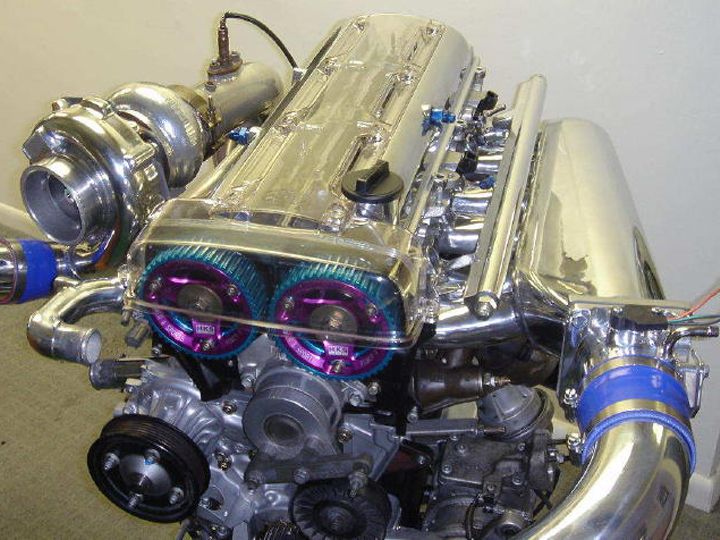Many have heard alphanumeric combinations: 3S-FE, 2L-TE, SR20DE, EJ20, etc., but do not know what this means. But by the name of Japanese engines you can learn a lot of valuable information. We hope that this article will help you become, if not experts, then more enlightened people in this matter.

TOYOTA

The names of Toyota engines are quite informative, second only to Nissan engines in this regard. So, the first character in the names of TOYOTA engines is a number intended to determine the serial number of the engine in the series. The second symbol tells us about the motor series (letter designation (can also be two-letter)). As a rule, this part of the engine designation is written in the technical passport.
Let's consider an example regarding engine series, the S engine series, the 3S-FE and 4S-FE engines are structurally the same (not absolutely, but very similar), they differ only in displacement and, if desired, they can even be swapped. Similar to 1AZ - 2AZ (two-letter markings appeared on engine series that appeared after 1990), 2L - 3L (single-letter markings tell us that the series appeared before 1990), 1ZZ - 2ZZ, etc. Moreover, there is no need to link the volume to the first number, according to the principle, the larger the engine capacity, the larger the number and vice versa, rather, a smaller number means an earlier year of development and nothing more. Do not confuse the year of production of a specific engine model with the year of production of a new series.
The 3S-FSE, 5S-FE, 3C-TE, 2C-E (and many others) engines were developed after 1990, but since they belong to the old S and C series, they have one letter before the dash. But there are not a single representative of the JZ, AZ, KZ, ZZ and other series with the letter Z in the name before 1990.
The name of the three-liter diesel engine 1KZ-TE (developed in 1993) is somewhat unusual, because its successor 1KD-FTV (also a three-liter diesel engine, but developed in 1996) has the letter D in its name. Presumably, since 1996, TOYOTA decided to use the letter D (Diesel) for the names of diesel engines, and the letter Z for gasoline engines. The letters following the dash indicate the design features of the engine, primarily the type of power supply and type of timing belt.
The first letter (or lack thereof) after the dash indicates the features of the block head and the “degree of boost” of the engine. If this is the letter F, then this is a standard power engine with 4 valves per cylinder and two camshafts in the cylinder head, the so-called High Efficiency Twincam Engine. In such engines, only one of the camshafts is driven by a belt or chain, while the second is driven from the first through a gear (engines with a so-called “narrow” cylinder head).
4A-FE, 1G-FE, 3E-FE, 3S-FE, etc.
If the first letter after the dash is the letter G, then the engine is boosted (there are also two camshafts in the cylinder head), each of the camshafts has a gear that has its own drive from the timing belt (chain). TOYOTA calls these engines High Performance Engine (engines with a “wide” cylinder head).
All engines with the letter G are gasoline and only with electronic fuel injection, quite often with turbocharging or charger. Examples: 4A-GE (maximum speed 8000 rpm), 3S-GE (maximum speed 7000 rpm), 1ZZ-GE. Engines with the letters F and G may belong to the same series (for example, 3S-FE and 3S-GE). Based on this, we can say that they are developed on the same basis (cylinder diameter, piston stroke (but not the piston) and much more are the same), but the designs of cylinder heads, timing belts and other engine elements differ.
The absence of an F or G after the dash means that the engine has only one intake and one exhaust valve per cylinder. 1G-E, 2C, 3A-L, 3L, 1HZ, 3VZ-E (and the camshaft will not necessarily be located in the cylinder head) The second after the dash (or the first, if the engine has two valves per cylinder) is a letter carrying information about the features of the engine:
T - available for all turbocharged engines (not to be confused with a charger): 1G-GTE, 3S-GTE, 4E-FTE, 2L-TE.
S - engine with direct fuel injection (developed after 1996): 3S-FSE, 1JZ-FSE, 1AZ-FSE.
X - engine, which is a hybrid power plant type, usually working in tandem with one or more electric motors. 1NZ-FXE, 2AZ-FXE
P - engine designed to run on liquefied gas (LPG (Liquefied Petrol Gas)): 15B-FPE, 1BZ-FPE, 3Y-PE
N - engine designed to run on compressed gas: 15B-FNE, 1BZ-FNE.
H - special fuel injection system, from some sources with variable intake manifold geometry (brand designation: EFI-D): 5E-FHE, 4A-FHE
The third after the dash (or the first - second, if the engine has two valves per cylinder and (or) does not belong to the category of engines with the letters T, S, N, X, P, H in the name after the dash) is a letter carrying information about the method mixture formation:
E - engine with multi-point electronic injection (EFI); for diesel engines this means that they are equipped with an electronically controlled high-pressure fuel pump (HPF): 4A-FE (petrol), 1JZ-FSE (petrol), 3C-TE (diesel).
i - engine with single-point (mono-injection) electronic injection (Ci - Central injector): 4S-Fi, 1S-Fi
V - only available on diesel engines 1KD-FTV, 2KD-FTV, 1CD-FTV, apparently denotes a Common Rail type power system (direct injection of diesel fuel).
If there are no letters E, i, V after the dash, then it is either a carburetor gasoline engine or a diesel engine with a conventional (mechanical) injection pump: 4A-F (carburetor engine, dual camshaft); 3С-T (diesel with mechanical fuel injection pump) Quite old TOYOTA gasoline engines (developed before 1988) may have the letters U, L, C, B, Z after the dash: 1G-EU, 1S-U, 2E-L, 3A-LU
L - transverse engine arrangement (3A-LU) or generally transversal for MR2
U - reduced toxicity (for Japan) (+catalyst)
C - reduced toxicity (for California) (+catalyst)
B – Twin Carb - two carburetors (obsolete code)
Z - SuperCharger (mechanical supercharger): example: 1G-GZE, 4A-GZE
Examples of TOYOTA engine names:
4A-FE - gasoline engine with 4 valves per cylinder and a “narrow” cylinder head, standard power range, with multi-point electronic fuel injection.
3C-T - diesel with 2 valves per cylinder, turbocharging and conventional (mechanically controlled) injection pump.
The 1JZ-GTE is a petrol engine with 4 valves per cylinder, a “wide” cylinder head, turbocharging and multi-point electronic fuel injection.
NISSAN

NISSAN engine markings are much more informative than engine names from other companies.
The first two letters in the name (gasoline engines had only one letter before development in 1983) indicate the engine series. Similar to Toyota engines, engines of the same series are structurally similar, but may differ in the fuel injection system, number of valves per cylinder, etc. For example, TD23, TD25 and TD27 are identical in design, but differ in displacement. Moreover, if the letter V comes first, then it is necessarily a V-shaped engine. If the second one is marked with the letter D, then it is definitely a diesel engine; if it is marked with another letter, then it is a gasoline engine. Next comes the number, dividing it by 10 to get the working volume in liters. CA20DE (petrol, in-line, 2.0 liter, DOHC), A15S (petrol, in-line, 1.5 liter, two valves per cylinder), TD27 (diesel, in-line, 2.7 liter, two valves per cylinder), CD17 (diesel, in-line, volume 1.7 liters, two valves per cylinder), VG33E (petrol, V-shaped, volume 3.3 liters, two valves per cylinder)
The first letter after the numbers indicates the design features of the cylinder head: D - engine with 4 valves per cylinder (TWIN CAM (twin - two, cam (camshaft) - camshaft) or DOHC - these are just different names for the same thing, divisions like TOYOTA does not have “narrow” and “wide” heads; all NISSAN engines have camshafts that are individually driven by a timing belt or chain). Example: ZD30DDTi, SR20DE, RB26DETT.
V - engine with 4 valves per cylinder and variable valve timing (analogous to VTEC systems for HONDA or VVT-i for TOYOTA). Example: SR16VE, SR20VE.
If after the numbers there is no letter D or V in the name of the NISSAN engine, this means that the engine has 2 valves per cylinder. Example: RB20E, CD20, VG33E.
The second letter after the numbers (or the first, if the engine has 2 valves per cylinder) indicates the method of forming the working mixture: E - multi-point (distributed) electronic fuel injection for gasoline engines (system brand designation - EGI), in the names of NISSAN diesel engines this letter does not occur. Example: SR16VE, CA18E, RB25DE.
i - single-point (central) electronic fuel injection for gasoline engines (Ci - Central injector); for diesel engines, this letter designates an electronically controlled injection pump and is the last (not second) in the engine name. Example: SR20Di (petrol), ZD30DDTi (diesel).
D - direct electronic fuel injection into the cylinders - for gasoline engines (DI - Direct Input system); For diesel engines, this letter means that the engine has undivided combustion chambers. Both petrol and diesel engines with a D in their name were developed after 1995. Example: VQ25DD (petrol); ZD30DDTi (diesel).
S - carburetor engine. Example: GA15DS, CA18S, E15ST.
If the NISSAN engine name does not have letters after the numbers (with the exception of the letter T, if the engine is equipped with a turbine), then it is a diesel engine with a conventional (mechanical) injection pump. Moreover, all such NISSAN engines had two valves per cylinder and separated combustion chambers, that is, there is no letter D after the numbers in the names of these engines. Example: CD17, TD42T, RD28.
The third letter after the numbers (or the first - second) indicates the presence of turbocharging. If there is a letter T after the numbers, this means that such an engine is turbocharged (precisely with gas turbine supercharging, since the NISSAN concern did not produce engines with a mechanical drive of the charge compressor from the crankshaft). If there are two letters T after the numbers, then this is an engine with two turbochargers (TWIN TURBO). Example: RD28T, RB25DETT, SR20DET, CA18ET
The fourth letter after the numbers can only be on engines with two turbochargers (this is the letter T, see example above) or on diesel engines with an electronically controlled injection pump. Example: RB25DETT, RB26DETT, YD25DDTi, ZD30DDTi.
Examples of NISSAN engine names:
A15S - gasoline in-line engine, displacement 1.5 liters, with 2 valves per cylinder (ONC), carburetor, without turbocharging.
CD17 is an in-line diesel engine with a displacement of 1.7 liters, with 2 valves per cylinder (ONC), mechanical fuel injection pump, without turbocharging.
VQ25DET - gasoline V-engine, displacement 2.5 liters, with 4 valves per cylinder (DOHC=TWIN CAM), multipoint (distributed) electronic fuel injection (EGI) and turbocharging. ZD30DDTi - diesel in-line engine, displacement 3.0 liters, with 4 valves per cylinder (DOHC) undivided combustion chambers, turbocharging and electronically controlled fuel injection pump.
SR20Di - gasoline in-line engine, displacement 2.0 liters, with 4 valves per cylinder (DOHC), central (single-point) electronic fuel injection, without turbocharging.
MITSUBISHI

The names of MITSUBISHI engines are quite uninformative.
If the first character in the engine marking is a number, then it shows how many cylinders there are. Example: 4D56 (4 cylinders); 6G72 (6 cylinders); 3G83 (3 cylinders); 8A80 (8 cylinders).
The next letter gives information about the engine type: A or G - gasoline engines. Example: 4G63, 8A80, 6G73.
1) D - diesel with a mechanically controlled high-pressure fuel pump (HPF). Example: 4D56, 4D68.
2) M - diesel with an electronically controlled injection pump. Example: 4M40; 4M41.
The last two digits indicate that the engine belongs to a specific engine series. Engines that have the same name (and, accordingly, belong to the same series) have a similar design, but may differ in the degree of boost, displacement, and method of power supply. However, the 4G13 and 4G15 engines have a corresponding name to the working volume: the first one is 1.3 liters, and the second one is 1.5 liters, which is more of an accident than a pattern. Based on the names of engines similar in design (that is, the same series), it can be assumed that the last digit in the name is the volume code, and the first three characters are the series. For example: 1) 6A10, 6A11, 6A12, 6A13; 2) 6G71, 6G72, 6G73, 6G74.
Old MMC engines (developed before 1989) might not have the first digit in the name indicating the number of cylinders, but they had a letter at the end, and the engine names became similar to the names of SUZUKI engines. Example: G13B (carbureted, 4-cylinder engine with 3 valves per cylinder)
HONDA

The first letter in the engine name indicates that the engine belongs to a specific series. Just like other Japanese engines, HONDA engines of the same series are structurally similar, but may differ in the degree of boost, displacement and other characteristics.
The next two digits show the engine displacement; dividing the number by 10 gives the displacement in liters. Example: D17A (engine capacity 1.7 liters), B16A (engine capacity 1.6 liters), E07Z (engine capacity 0.66 liters).
The last letter (there are letters A, B, C, Z) denotes an engine modification in the series, engines with a letter, and similarly to the alphabet, the first modifications correspond to the first letters of the alphabet and then in descending order, that is, the first modification always has the letter A, the second B and then in descending order analogies. Example: B20A, B20B; D13B, D13C; B18B, B18C.
Old HONDA engines have two-letter markings, information about which can only be obtained from catalogs. For example: ZC (installed on the Integra model until 2001, it was available in both carburetor and injection versions, as well as two-, single-cam, VTEC and simple)
SUBARU

The first one or two (in most cases) letters indicate the engine's belonging to the engine series. All engines in the series are structurally similar, but may differ in displacement, the presence or absence of turbocharging (for example, the EJ20 can be with a turbine, with two turbines (twin turbo) or without them) and other elements.
The next two digits show the engine displacement; dividing the number consisting of these digits by 10 gives the displacement in liters. For example: EJ25TT (2.5 liter displacement, Twin Turbo), EJ15 (1.5 liter displacement), EF12 (1.2 liter displacement), EN07 (0.66 liter displacement), Z22 (working volume 2.2 l.).
Old SUBARU engines had two numbers in their names that had nothing to do with displacement. EA71 (working volume 1.6 l.)
MAZDA

Older engines had only two letters in their names; newer engine designs have additional letters after the dash; in addition, instead of two letters at the beginning, there may be a letter and a number or three letters.
The first letter in the name (both new and old engines) indicates that the engine belongs to a specific series, the engines of which may differ in displacement.
The second letter indicates a modification in the series (usually an engine with a different displacement).
K8 (working volume 1.8 l.), FS (working volume 2.0 l.), R2 (2.2 l.), KL-ZE (2.5 l.)
Additional letters after the dash (for engines of the latest years of development) serve to indicate the design of the cylinder head and the method of filling the cylinders with the working mixture.
The first letter after the dash shows the design features of the cylinder head: Z or D - two camshafts (DOHC), 4 valves per cylinder. Example: JE-ZE, Z5-DE, KL-ZE
M – one camshaft, 4 valves per cylinder. Example: B3-MI, B5-ME.
R - for a Wankel rotary piston engine. Example: 13B-REW.
If there are no letters Z, D or M after the dash, then this engine has 2 valves per cylinder (this applies to fairly recent engines). Example: FE-E, JE-E, WL-T.
The second letter after the dash (or the first if the engine has 2 valves per cylinder) shows the method of creating the working mixture in the cylinders:
1) E - multi-point (distributed) electronic fuel injection. Example: FE-E, B5-ME.
2) I - single-point (central) electronic fuel injection. Example: B5-MI.
3) T - after the dash indicates the presence of turbocharging. Example: WL-T, RF-T.
SUZUKI

The first letter indicates the series to which the engine belongs. Similar to other Japanese brands, all engines in the series are similar, but may have different displacements, injection systems, and have slight design differences.
The next two digits show the engine displacement; dividing this number by ten gives the displacement in liters.
K5B (working volume 0.55 l.), M13A (working volume 1.3 l.), J20A (working volume 2.0 l.), H25A (working volume 2.5 l.)
DAIHATSU

The first two letters indicate the series to which the engine belongs. All engines of the same series are structurally similar, but may have different injection systems and head designs. Examples: EF-DET (turbocharged), EF-VE (non-turbocharged).
The letters following the dash indicate the design features of the engine, but the purpose of some letters is unclear (for example, HE-EG and HD-EP engines).
T - presence of turbocharging. Example: K3-VET.
D or Z - the presence of two camshafts. Example: EF-ZL, EJ-DE.
E - multi-point (distributed) electronic fuel injection. Example: HE-EG, HC-E
V - engine with 4 valves per cylinder, two camshafts and variable valve timing (analogous to VTEC systems for HONDA or VVT-i for TOYOTA). Example: EJ-VE, K3-VET.
ISUZU

The first number in the engine marking indicates the number of cylinders in the engine.
The next two letters indicate whether the engine belongs to the series. But at the same time, if the first of these two letters is V, then it means the engine is V-shaped.
The last digit indicates the engine modification number in the series.
6VE1 - 6-cylinder V-shaped gasoline engine with a volume of 3.5 liters.
6VD1 - 6-cylinder V-shaped gasoline engine with a volume of 3.2 liters.
4JX1 - 4-cylinder in-line diesel engine with a volume of 3.0 liters.





















